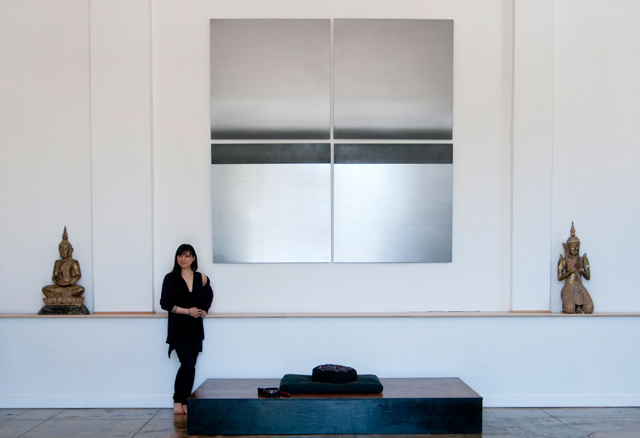
We caught up with the latest addition to Element Eden Advocate’s, Miya Ando. Not only is her art very unique and different from anything else we’ve seen so far, she is also a very unique person herself with a very special background. Read on to learn more…
Interview by Anna Langer, Portrait by Anthony Gamboa
You are working with metal, which isn’t the most common material for artists. How did the idea to use such an unusual material as metal come about?
I am a descendant of Bizen swordmaker Ando Yoshiro Masakatsu and I was raised amongst sword smiths-turned Buddhist priests. Being of mixed background, Japanese and Russian, I could not follow the traditional religious way of life, however I still wanted to honour my people and my past. I chose to do this unconventionally, through art, by working with steel in such a way that continues the tradition in a new form.
What makes metal special compared to other substances?
Steel is a material of strength and permanence and those properties are an appropriate ground for aesthetic reductivism, and a study of impermanence.
You describe your art as “meditative works“. How can we understand that?
The works are created through a process of introspection that involves action and reaction to the material itself. One could understand the work as in invitation to enter a state beyond critical thought.
What role does spirituality play in your art?
I grew up in a Buddhist temple. My views and my working method are informed by a spirituality that my family has shared for generations, and my work is homage, a continuation of these beliefs in a contemporary form.
Before you started art you went to university.
Yes, my interest in school was Buddhist Iconography, in particular Didactic Mahayana imagery. My interest is in distilling that imagery to the extent that it becomes non-denominational, universal in a sense.

Miya created this piece for the Dharma Punx/Against the Stream Buddhist Meditation Society space in Los Angeles, it is meant to serve as a meditation aid to the Buddhist Sangha there. Photo: Cat Gwynn
Most of your pieces are quite huge, why is that?
Some of my works are large – the experience of immersion that large scale works may achieve is of interest to me.
Why did you decide to start to make smaller ones too?
The materials I use lend themselves to variation, and my processes may adapt to changes in scale. My art practice is about developing a certain relationship to the physical world, to materiality, and size or scale is of little importance in this matter. I decided to work smaller to be able to show my work in smaller contexts, it was a question of site specificity.
What’s the difference in them besides the size? What difference does the size make for you personally and as an artist?
All the colours and tones in my work exist somewhere between the dark black of oxidized steel and the pure grey of freshly cut steel. I have chosen to work within this restricted field, to narrow my engagement, because I believe that it is through this form of restraint that one can experience the subtle shifts and the beauty of the material. My working method is physical and meditative, and the motions I go through vary to produce different compositions.

What message do you want to spread with your art?
I do not regard the work as didactic, however I would like the viewer to sense through the work that even the strongest materials of the earth are impermanent. I invite the viewer into a meditative space, and it is my hope that these spaces inspire introspection, reflection and solace. My intention is to put forth quiet environments which come from a place of sincerity and compassion.
With the sale of your smaller pieces you support the ‘Indigo Youth Movement’. Can you tell us more about that?
I believe that marginalized children should have support, and I was in a position to provide that. My friend Dallas Oberholzer, another Element Advocate, started the Indigo Youth Movement – when he told me about this project I was so inspired by the compassionate and sincere nature of the organisation and the good that they were doing, I wanted to help.
Why is charity important to you?
It’s an extension of the work, as social action.
Which projects do you have planned in the near future?
I have two solo shows coming up in December and in January. I am also working on a large-scale public piece for a nondenominational chapel in a Women’s Homeless shelter and rehabilitation facility in Louisville, Kentucky.
Also something in the long run?
I would like to come to visit Munich someday and personally thank you and Cooler magazine for the interest and interview!

